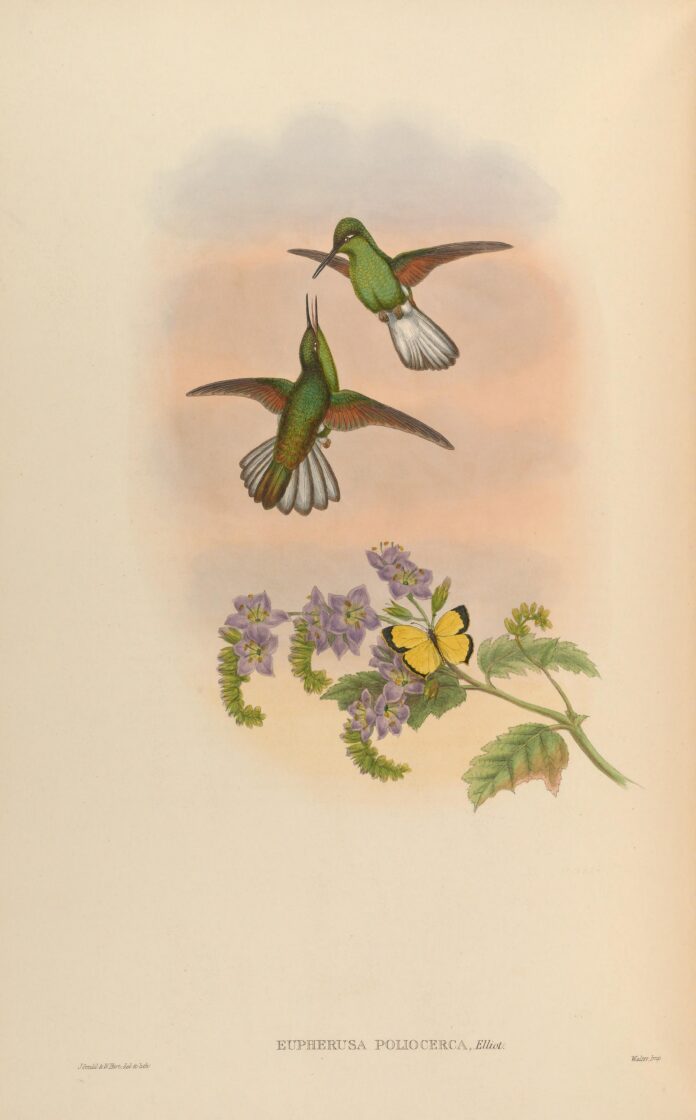
WILLIAM Matthew Hart may not be a name familiar to many, but his hand helped shape how people in the 19th century saw the natural world.
A brilliant illustrator and lithographer, Hart worked closely with one of Victorian England’s most renowned ornithologists, John Gould, creating dazzling images of birds from across the globe – particularly the iridescent hummingbirds and flamoyant birds-of-paradise that captivated the imagination in a time before colour photography.
Hart was born in the Castle Barracks, and, on May 12, 1830, baptised as a non-conformist in Limerick. His father, also named William Matthew Hart, was an artist, while his mother, Sarah Jones, was the daughter of a coal merchant. The couple were in Limerick with the 56th Regiment of Foot, with whom William Snr was presumably serving at the time.
The 56th Regiment of Foot was an infantry regiment in the British Army, active from 1755 to 1881. It was stationed at various locations in Ireland to assist maintaining order during the Repeal movement. The Repeal Association was an Irish mass membership political movement set up by Daniel O’Connell in 1830 to campaign for a repeal of the Acts of Union of 1800 between Great Britain and Ireland.
The regiment remained in Ireland until it moved to England in 1844, taking the Hart family with it.
By the time of his marriage to Harriet Firminger in 1855, Hart and his parents were living in London. There is a tale that Hart returned to Limerick a year later, where his eldest son, also called William, was born, but this cannot be confirmed by available sources.
According to family lore, Hart was originally set on a career in medicine, but was forced to abandon his studies due to financial constraints. He instead turned to illustration, likely encouraged by his father’s artistic background.
At just 21 years old Hart began working with John Gould, a keen ornithologist often referred to as ‘the father of bird study in Australia’, and was known for his ambitious, lavishly illustrated monographs on birds. The illustrations in these publications relied on a network of talented artists, including his wife Elizabeth Gould, Edward Lear (who popularised the Limerick poem), Henry Constantine Richter, and the Limerick-born William Matthew Hart.
Cornerstone of Victorian natural history
Hart began humbly, hand-colouring printed plates and adding the metallic touches that gave Gould’s birds their lifelike sheen. However, his ability with colour and fine detail soon set him apart. He was quickly tasked with creating master pattern plates and eventually took on the role of lithographer. By 1870, he had become Gould’s chief artist and lithographer, and frequently coloured the finished plates. During this period, he worked on The Birds of New Guinea and lithographed 141 of Gould’s sketches.
One of Hart’s most notable contributions was to A Monograph of the Trochilidae, or Family of Humming-birds, a sumptuous series that remains a cornerstone of Victorian natural history illustration. He also worked extensively on The Birds of Great Britain, and later The Birds of New Guinea, lithographing more than 140 of Gould’s original sketches.
The Limerick man did not just look to the sky for his artistic inspiration. In at least on instance he painted a trout, which was caught by Gould and was proudly displayed in his employer’s home.
Following Gould’s death in 1881, Hart was retained by Dr Richard Bowdler Sharpe of the British Museum to complete The Birds of New Guinea and to produce illustrations for a monograph on birds-of-paradise, subjects whose bold, tropical colouring perfectly suited Hart’s vivid artistic style.
Though his draughtsmanship was sometimes considered less anatomically precise than that of his predecessor Richter, Hart was praised for his meticulous attention to backgrounds, rendering foliage and natural elements with a level of care that helped contextualise the birds in their imagined habitats.
Anonymous and overshadowed
Hart lived at 109 Colman Road in Camberwell, London, for at least the last 30 years of his life. In 1891, the widowed Hart was living there with his son Edgar, when the census return for that year was taken. He recorded his occupation as ‘Ornithological Artist, Colour’. The enumerator, upon seeing this added his own note, one simple word: Bird.
Hart’s watercolours are now on display in galleries and museums throughout the world and fetch thousands at auction. In 1995, one of his watercolours depicting Ceylon Birds, published by the Zoological Society in 1872, reached £2,300 at Christie’s auction house. Editing notes that can be seen in this watercolour with faint pencil marks, perhaps by Gould, suggest that the tail of the upper bird should be raised, the background grasses should continue upwards, and the upper bird reversed.
Today, Arader Galleries is selling Hart’s depiction of the Quezal or Pharomacrus mocinno, from the 1875 publication A Monograph of the Trogonidae, of Family of Trogons, for over €133,000.
Hart continued to live and work in London, raising a large family of at least seven children, and listing his profession as “lithographer and print colourer” in official records. He died on January 24, 1908, and was laid to rest in Camberwell Old Cemetery.
Despite the importance of his work, Hart’s name never achieved the renown of the men for whom he worked. His contributions were often anonymous, his signature omitted or overshadowed by the dominant figure of Gould. Only later, posthumously, did Hart receive some of the recognition he so richly deserved.


